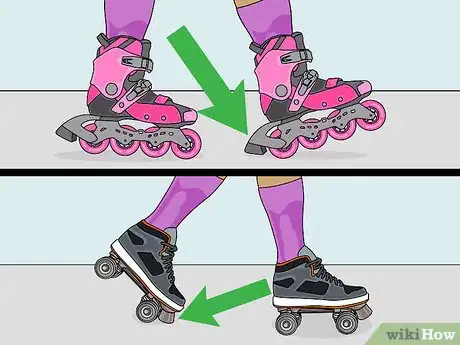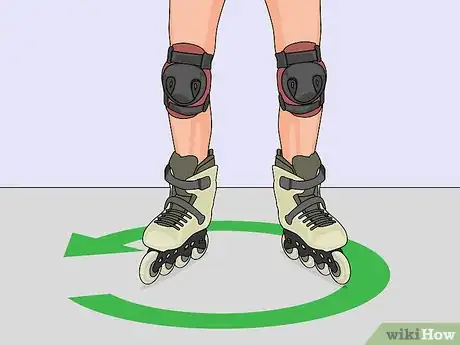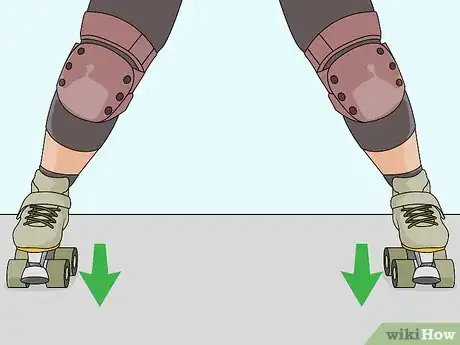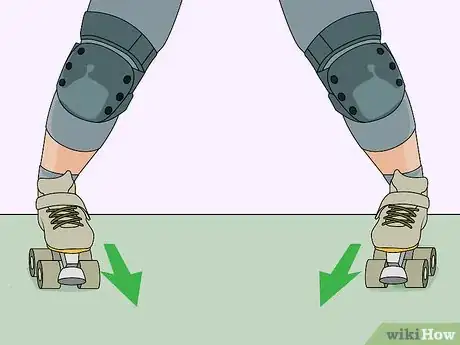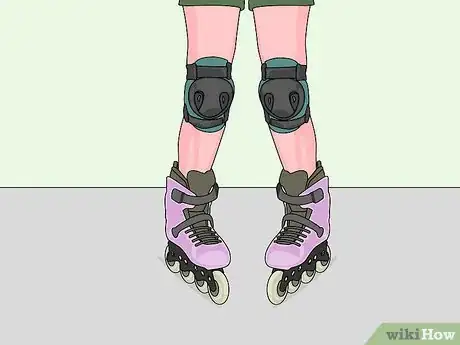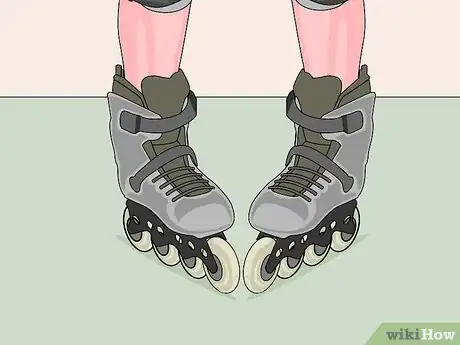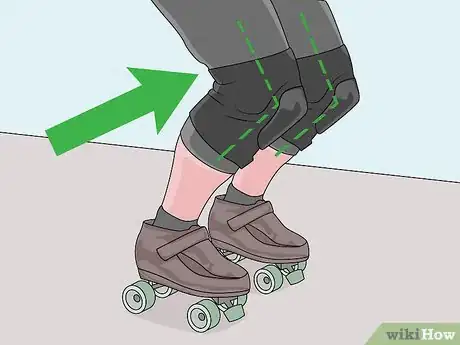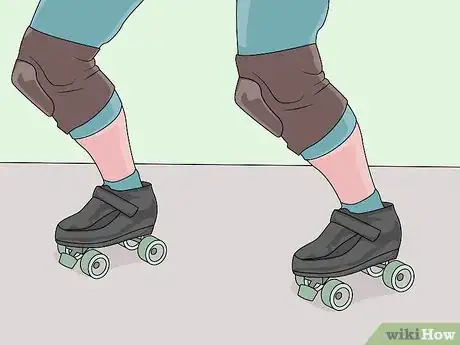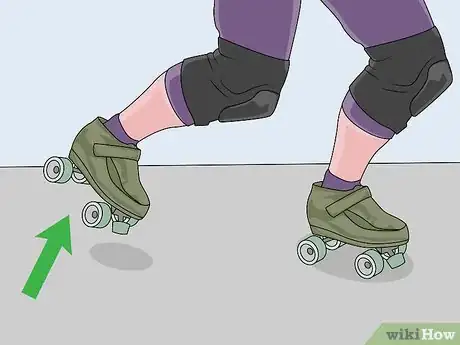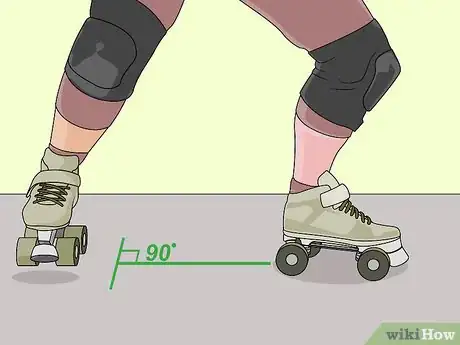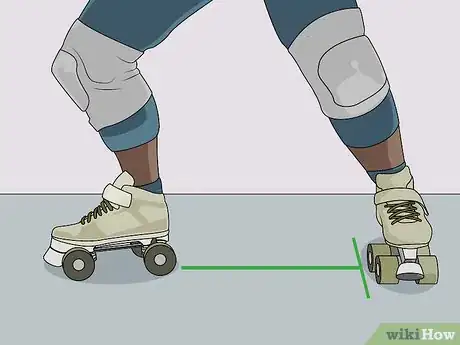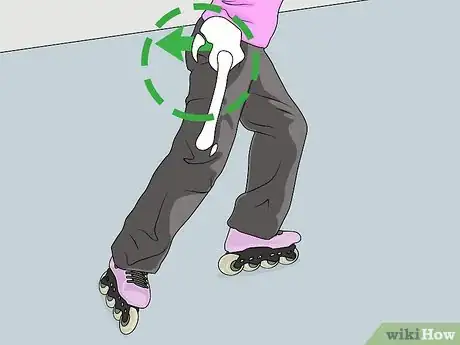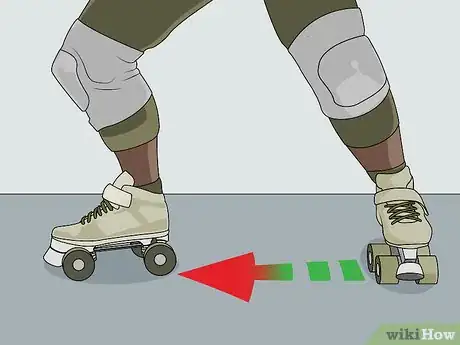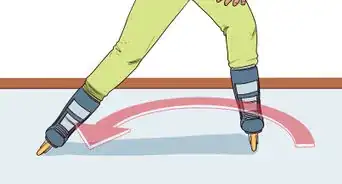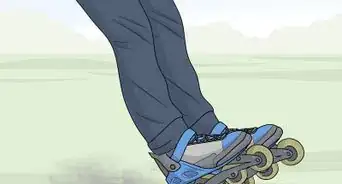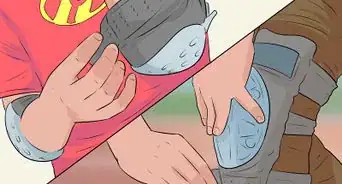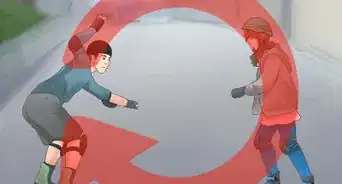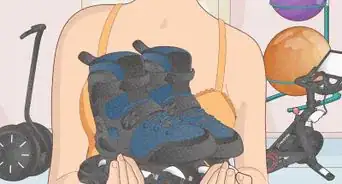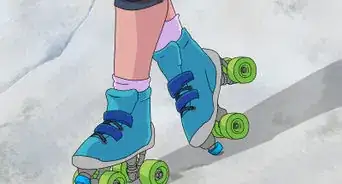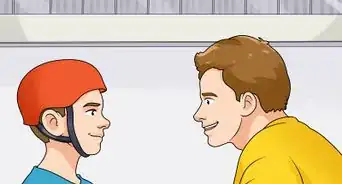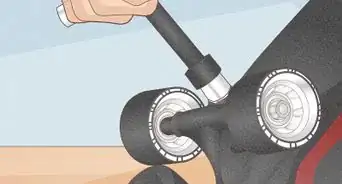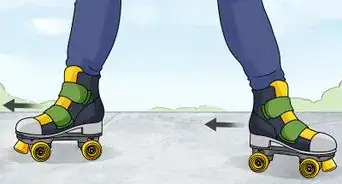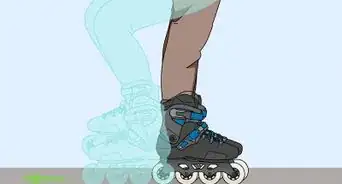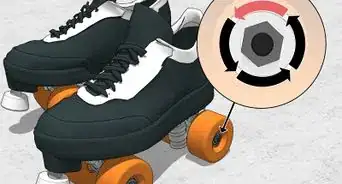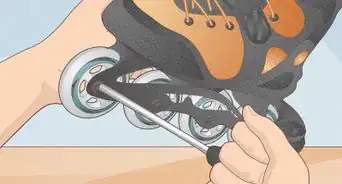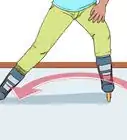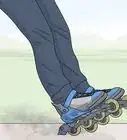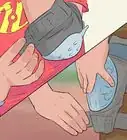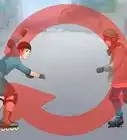This article was co-authored by wikiHow Staff. Our trained team of editors and researchers validate articles for accuracy and comprehensiveness. wikiHow's Content Management Team carefully monitors the work from our editorial staff to ensure that each article is backed by trusted research and meets our high quality standards.
There are 7 references cited in this article, which can be found at the bottom of the page.
wikiHow marks an article as reader-approved once it receives enough positive feedback. In this case, 92% of readers who voted found the article helpful, earning it our reader-approved status.
This article has been viewed 152,242 times.
Learn more...
Though the overall popularity of skating may have dwindled, it is still an activity many people enjoy. Learning to skate involves getting your balance, practicing turns, and changing speed, but learning to stop is extra important because not being able to stop affects your safety. You can learn to T-Stop by scissoring your legs, planting your back foot perpendicular, and dragging it to a stop, and plow stop by spreading your legs wide and pointing your toes inward to increase friction. You can also learn a few other methods like the knee stop and spinout stop.
Steps
Learning Basic Stops
-
1Use your knee pad to stop. Since it is typically recommended to wear safety gear when you are skating, you should have knees pads on already. To perform this stop, slowly lower one knee to the ground and allow it to drag. This is a good stopping technique for beginners as it takes very little skill to perform. You don’t want to rely on it, just use it as a backup when necessary.[1]
-
2Use the heel or toe brakes. Since inline skates typically have a heel brake and quad skates have toe stops, these are a basic, common way to stop. Both brakes are best used with your legs scissored, one forward and one back. To use the heel brake, the skate with the heel brake should be forward. Lift your front foot toes and gently apply pressure to the brake. To use toe stops, lift your back leg heel and apply pressure to the toe stop. On roller skates when using the toe stops you must be skating backwards or else you can cause serious damage to your feet and ankles.[2]Advertisement
-
3Perfect the spinout stop. Plant one foot and allow the other foot to trace a wide circle around your body. This transfers your motion from forward to circular movement, which slows you down to a stop while keeping you fixed in one location. This is most effective if you plant your dominant foot and allow your non-dominant foot to trace the circle around you. This is also an effective movement if you just want to slow down and not come to a complete stop.[3]
Performing a Plow Stop
-
1Spread your legs wider than your shoulders. Although you most likely skate with your feet about shoulder-width, to make this stopping technique most effective you must widen your stance. As you do this, it is helpful to bend the knees a little, as well. Don’t spread your legs so wide that it feels like a strain, just make them wider than they normally would be during skating.[4]
-
2Point your toes slightly in toward each other. Slowly angle your feet so that your toes are pointing toward the center. The natural tendency of your feet may be to close the gap between them when you point your toes, but you want to make sure you keep a wide stance for now. You want to make sure not to point them too sharply inward or you may end up falling. Angle them just enough that you can tell they are pointed in.[5]
- Pointing your toes inward makes the wheels roll at a slight angle which creates more friction than if they were pointing straight forward. This is where the stopping power comes from.
-
3Bring your feet slowly closer together. Pointing your toes inward will already start to slow you down, but coming to a full stop, especially if you need to stop quickly, requires you to bring the feet closer together. Going from a wide stance to a very tight stance may make you feel a little wobbly, so go slow and keep the knees slightly bent rather than straight and rigid.
-
4Let the inside wheels rub each other. Once your feet are close and still pointing inward, adjust so that the front wheels are just barely touching. Allowing the wheels to rub together adds just enough friction to slow you down all the way to a stop. Again, you don’t want to let them slam together and rub so hard that you stop immediately as this will likely result in you losing balance and falling forward.
Using the T-Stop
-
1Bend your knees. This is good posture for skating anyway, but bending the knees slightly is important for stopping because it helps you keep your balance. It also makes the movements easier to perform. You don’t need to be crouching down in a sitting position, just have them bent slightly past straight. The bend in the knees gives you a lower center of gravity.[6]
- How much you bend your knees can be affected by your height, such that taller people may want to bend their knees a little more for better balance.
-
2Move your non-dominant foot farther back. As you are still moving, slowly scissor your legs so that your non-dominant foot (whichever one you’d be less likely to kick a ball with) slides backward. At the same time, move your dominant foot a little more forward. Keep both feet facing forward for the time being.[7]
- Shift the majority of your weight onto your front foot. This may feel a little awkward at first and it takes good control of your balance, so practice this part a lot. Keeping weight off of your back foot prepares you to move it while performing the stop.
-
3Lift your back foot off of the ground. Lift your back foot off the ground just enough so you are able to turn the foot sideways. You don’t need to lift it high in the air, but make sure it doesn’t touch the ground yet until you get it positioned properly. This will require you to glide momentarily with weight only on your front foot.
-
4Turn your back foot perpendicular to your front foot. Perform this part at the same time as lifting your foot to create a smooth motion of lifting and turning. When you turn your foot, it should be sideways, with your toes pointing outward, as much as possible. The goal is to have this foot be at a 90-degree angle to your front foot.[8]
-
5Place your back foot on the ground. Do this gently rather than stomping your foot down. At 90 degrees to your front foot and keeping your legs scissored, set the foot down. It should be about one foot behind your front foot. Even as you set the foot back down, you don’t want to put much of your actual weight on the back foot. You will simply apply a bit of pressure.[9]
- The movement of lifting the foot, turning the foot, and setting the foot back down should be done as quickly and smoothly as you can. The goal is to have the three motions turn into one smooth motion.
- Remember that since your legs are scissored and your foot is pointing sideways that it will come down onto the ground at a slight angle towards the rest of your body. Your front leg skate will be straight up but your back skate will be at an angle.
-
6Keep your hips aligned forward. It is easy to start spinning or veering to the side if you let your hips loosen up to face sideways, which would feel more comfortable. If you let your hips open up to the side, you won’t keep going forward like you want to. Be sure that you keep the hips squared forward with your front foot. This also takes conscious effort as it can feel like a strain.
-
7Drag your back foot until you stop. Do not put weight on the back foot, just apply enough pressure to slow you down. The more pressure you apply, the faster you will stop. Gauge how much stopping room you have and apply pressure accordingly.[10]
Community Q&A
-
QuestionIf I’m nervous, how do I calm myself down to actually skate?
 Lesley OchioraCommunity AnswerFalling is a part of the process of learning sometimes. You only need 2 things, the courage to get back up when you fall, and good safety gear when you fall.
Lesley OchioraCommunity AnswerFalling is a part of the process of learning sometimes. You only need 2 things, the courage to get back up when you fall, and good safety gear when you fall. -
QuestionHow do you balance yourself on the roller skates (quads)?
 IforgotmyoldpassCommunity AnswerKeep your knees slightly bent and always lean slightly forward (falling backwards will hurt way more.)
IforgotmyoldpassCommunity AnswerKeep your knees slightly bent and always lean slightly forward (falling backwards will hurt way more.) -
QuestionWill the brakes of roller skates eventually wear off?
 IforgotmyoldpassCommunity AnswerYes, but it will take a very long time. It also depends on what material it’s made out of, with inline skates the brake is a hard piece of plastic whereas with quad skates the brake is rubber.
IforgotmyoldpassCommunity AnswerYes, but it will take a very long time. It also depends on what material it’s made out of, with inline skates the brake is a hard piece of plastic whereas with quad skates the brake is rubber.
References
- ↑ https://howtheyplay.com/misc/How-to-Stop-in-Roller-Skates-for-Beginners
- ↑ http://londonskaters.com/how-to-stop-on-inline-skates-using-a-heel-brake/
- ↑ http://www.skatefaq.com/skate.2.1.html
- ↑ https://howtheyplay.com/misc/How-to-Stop-in-Roller-Skates-for-Beginners
- ↑ http://www.skates.com/how-to-skate-s/84838.htm#tstop
- ↑ http://www.hockeytutorial.com/inline-hockey-tips/how-to-hockey-stop-on-inline-roller-hockey-skates-for-beginners/
- ↑ http://www.skatefaq.com/tutorials/t-stop/t-stop.tut.html
- ↑ http://www.skates.com/how-to-skate-s/84838.htm#tstop
- ↑ http://www.online-skating.com/articles-682-apprendre-a-freiner-en-t-en-roller.html
About This Article
Roller skating is great fun, but you’ll need to know how to slow down and stop to stay safe in the rink. Before you start skating, check where the brakes are on your skates. If your skates have a row of wheels in the middle, they’ll probably have heel brakes. If they have 2 sets of 2 wheels, they’ll usually have toe brakes. To use heel brakes, place your foot with the heel brake in front. Then, lift your toes and gently apply pressure to the brake. To use a toe brake, straighten your back leg behind you so your toe’s pointing at the ground and apply gentle pressure. If you’re wearing knee pads, which you really should be, you can also lower one knee and drag it along the ground. This is an easy way to brake for beginners or as a backup if something goes wrong. For more Roller Skating tips, including how to do a T-stop, read on!

